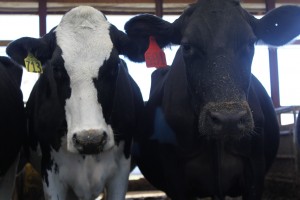By: Tessa Hahn
Pearly whites: This spotted specimen, having no upper front teeth, actually has fewer teeth than most other animals.
Tongue-tied: Cows, lacking in upper teeth, use their tongue to grab their food. It then tumbles down their digestive system, hitting the rumen ground hard.
Dairy’s Digest: The rumen, the first of a cow’s four stomachs, holds the grass and plants and hay—oh my—until the cow can eat no more. Exhausted from the excessive chewing and standing, she plops down on a soft spot of grass to take a well-deserved rest. Whilst lounging and digesting, the cow’s food makes just short of a public reappearance. Climbing back to the teeth via the second stomach’s highly lauded rumination express, the cud awaits its proper second chew and grind, before sliding back down to the shadows of a cow’s underbelly.
Slip and Slide: After a journey down the esophagus, through stomach one (rumen), up stomach two (reticulum)—pause for a short break of second-time’s-the-charm chewing—the food finally shoots through stomachs three (omasum) and four (abomasum).
Nutritional Science 101: The long adventure up, down and around the cow proves to be quite healthily worth it. Cows, unlike most other mammals, are thus capable of digesting hardier plants. These nutrients, happy and healthy as can be, make their way to the udders, ready to pay it forward to the dairy-eager world this cow lives in.
Udders: In her lifetime, a dairy cow will produce about 200,000 glasses of milk. That’s 547 years worth of one-glass-a-day human dairy consumption. Holy cow!
Farm Facts: Animal friendly: Cows are happy herbivores that eat their grass with vegetarian sass.
Related posts:

